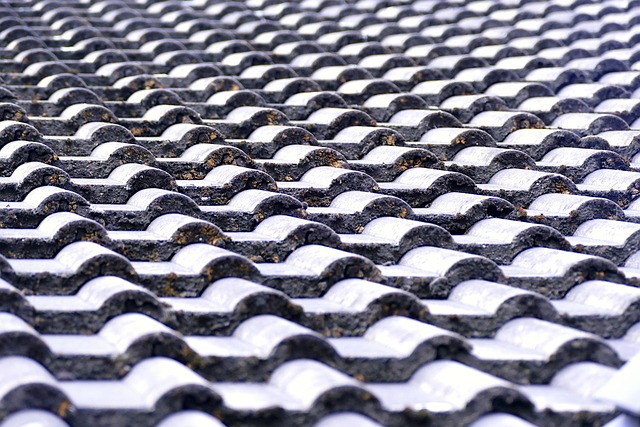When considering a roof replacement, homeowners have several options: asphalt shingles for affordability, metal roofs for longevity and energy efficiency, tile roofs for luxury, or synthetic materials for eco-friendliness. The best choice depends on climate, local regulations, personal style, and property needs. Regular inspections are key to maintaining a roof's integrity. High-quality roofing materials protect against weather, enhance curb appeal, and can reduce utility bills. Roof replacement involves removing old roofs, inspecting the structure, installing underlayment and new material in a methodical pattern, adding flashing, and cleaning up. Common mistakes include neglecting structural inspections, choosing inferior materials, DIY installation, or skimping on labor, which can lead to costly repairs. Professional roofers ensure proper installation using suitable materials for local conditions. Regular maintenance, including seasonal care and tree trimming, ensures optimal roof condition.
Roof replacement is a significant investment for homeowners, but understanding your residential roofing options can ensure a durable and aesthetically pleasing finish. This article guides you through the process, from selecting suitable materials to navigating project steps. Learn about signs prompting roof replacement, common mistakes to avoid, and essential tips for maintaining your new roof. Discover the impact of quality roofing materials on energy efficiency and home value.
Understanding Your Residential Roofing Options

When considering a roof replacement, homeowners have a variety of residential roofing options to choose from. Each type offers unique advantages and considerations in terms of durability, aesthetics, and cost. Asphalt shingles remain a popular choice due to their affordability and ease of installation, making them a go-to option for many. Metal roofs are gaining traction for their longevity and energy efficiency benefits, while tile roofs offer a more luxurious look that can enhance home value.
Additionally, synthetic roofing materials like composite or fiberglass provide an eco-friendly alternative to traditional options. Each material comes with its own set of pros and cons, so it’s essential for homeowners to research and understand the specific needs of their property before making a decision. Factors like climate, local regulations, and personal style should guide the selection process to ensure a durable and aesthetically pleasing residential roofing solution.
When to Consider Roof Replacement

Many homeowners often wonder when it’s time to consider replacing their roof, an essential aspect of residential roofing. While a roof’s lifespan varies depending on factors like material and installation quality, general wear and tear, and local climate conditions, several signs indicate that it might be time for an upgrade. One of the primary indicators is visible damage, such as missing or damaged shingles, leaks, or signs of weakening or rot in the roof structure. These issues not only compromise the structural integrity of your home but also lead to further complications if left unaddressed.
Regular inspections can help homeowners stay proactive about their roof’s health. If you notice an increase in energy bills, despite adequate insulation, it could be a sign that your roof is no longer performing efficiently. Similarly, when your attic shows signs of moisture or mold growth, or there are unusual noises during storms, these should prompt an investigation. Ultimately, if your roof is nearing its estimated 20-30 year lifespan or exhibits significant deterioration, considering a residential roofing replacement might be the best course of action to ensure your home remains protected from the elements and maintain its overall value.
The Impact of Quality Roofing Materials

When considering roof replacement for your home, investing in high-quality roofing materials is paramount. The right materials can dramatically impact your residential roofing’s longevity, durability, and overall performance. They shield your home from harsh weather conditions, insulate against extreme temperatures, and protect against leaks that could cause costly interior damage.
Moreover, modern roofing options offer an array of aesthetically pleasing designs and colors, allowing homeowners to enhance their property’s curb appeal. Energy-efficient materials can also contribute to reduced utility bills by providing superior insulation. Ultimately, choosing quality roofing components for your residential roofing project is a strategic decision that ensures your home stays protected for years to come while potentially increasing its overall value.
Steps Involved in a Roof Replacement Project

Roof replacement is a significant home improvement project, but understanding the process can help make it less daunting. The first step in any residential roofing project is preparing for the work. This involves removing the old roof, which may include tearing off shingles or tiles, and disposing of the debris safely. Once the existing structure is cleared, an inspection is conducted to assess the condition of the roof frame, trusses, and underlayment. Any necessary repairs or replacements are made during this phase to ensure a solid foundation for the new roof.
After the preparation comes the installation of the new roofing system. This typically involves laying down a layer of underlayment, followed by installing the chosen roofing material—such as shingles, tiles, or metal panels—in a methodical pattern to ensure even coverage and protection against leaks. Flashing is then added around various roof penetrations like chimneys and vents, providing an extra barrier against moisture intrusion. Finally, a thorough cleanup ensures that no debris remains, and any final touches, such as installing new gutters, complete the residential roofing project.
Common Mistakes Homeowners Make During Replacement

Many homeowners undertake roof replacement thinking it’s a straightforward process. However, common mistakes can lead to costly repairs and even further damage. One of the most frequent blunders is failing to inspect the entire roof structure thoroughly. A residential roofing project requires careful evaluation of every component—from the underlayment to the shingles—to identify weak spots that need addressing. Neglecting this step often results in issues like poor drainage or improper ventilation, which can compromise the new roof’s integrity.
Another error is selecting an inferior roofing material based solely on cost. While affordability is a factor, choosing high-quality materials tailored to your climate and local weather patterns ensures better durability and long-term savings. Moreover, skimping on labour or attempting DIY installation can be hazardous and lead to subpar results. Professional roofers have the expertise and tools to ensure proper installation, flashing, and sealing, creating a robust barrier against the elements for your residential roofing system.
Tips for Maintaining Your New Roof

After installing a new roof, proper maintenance is key to ensuring its longevity and protecting your home from potential damage. Regular inspections are essential; check for any loose or damaged shingles, especially after severe weather events. Keep an eye out for signs of wear and tear, such as leaks or missing flashing, as these issues can lead to more extensive problems down the line.
To maintain your residential roofing system, consider seasonal care. In spring, clean gutters and downspouts to prevent clogs that could impact drainage. During autumn, inspect the roof for any debris buildup and address it promptly. Additionally, keeping trees well-trimmed around the perimeter of your home can help reduce the risk of branch damage during storms, ensuring your new roof remains in top condition for years to come.
